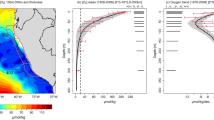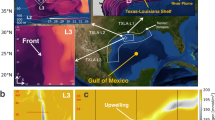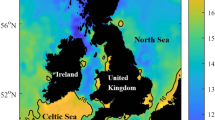Abstract
Dissolved oxygen in sea water affects marine habitats and biogeochemical cycles1,2,3. Oceanic zones with oxygen deficits represent 7% of the volume and 8% of the area of the oceans4, and are thought to be expanding4,5. One of the most pronounced lies in the region off Peru, where mesoscale activity in the form of fronts and eddies is strong. Here, we study the dynamics of the Peruvian oxygen minimum zone in a Lagrangian framework, using a coupled physical–biogeochemical numerical model and finite-size Lyapunov exponent fields, to evaluate the role of mesoscale activity. We find that, at depths between 380 and 600 m, mesoscale structures have two distinct roles. First, their mean positions and paths delimit and maintain the oxygen minimum zone boundaries. Second, their high-frequency fluctuations inject oxygen across the oxygen minimum zone boundaries and eddy fluxes are one order of magnitude higher than mean oxygen fluxes. We conclude that these eddy fluxes contribute to the ventilation of the Peruvian oxygen minimum zone.
This is a preview of subscription content, access via your institution
Access options
Subscribe to this journal
Receive 12 print issues and online access
$259.00 per year
only $21.58 per issue
Buy this article
- Purchase on Springer Link
- Instant access to full article PDF
Prices may be subject to local taxes which are calculated during checkout



Similar content being viewed by others
References
Gnanadesikan, A., Dunne, J. & John, J. Understanding why the volume of suboxic waters does not increase over centuries of global warming in an earth system model. Biogeosciences 9, 1159–1172 (2012).
Lam, P. et al. Revising the nitrogen cycle in the Peruvian oxygen minimum zone. Proc. Natl Acad. Sci. USA 106, 4752–4757 (2009).
Ward, B. et al. Denitrification as the dominant nitrogen loss process in the Arabian Sea. Nature 461, 78–81 (2009).
Paulmier, A. & Ruiz-Pino, D. Oxygen minimum zones (OMZs) in the modern ocean. Prog. Oceanogr. 80, 113–128 (2009).
Stramma, L., Johnson, G., Sprintall, J. & Mohrholz, V. Expanding oxygen-minimum zones in the tropical oceans. Science 320, 655–658 (2008).
Chavez, F. & Messie, M. A comparison of eastern boundary upwelling ecosystems. Prog. Oceanogr. 83, 80–96 (2009).
Penven, P., Echevin, V., Pasapera, J., Colas, F. & Tam, J. Average circulation, seasonal cycle, and mesoscale dynamics of the Peru current system: A modeling approach. J. Geophys. Res. 110, C10021 (2005).
Montes, I., Colas, F., Capet, X. & Schneider, W. On the pathways of the equatorial subsurface currents in the eastern equatorial Pacific and their contributions to the Peru-Chile Undercurrent. J. Geophys. Res. 115, C09003 (2010).
Chaigneau, A., Gizolme, A. & Grados, C. Mesoscale eddies off Peru in altimeter records: Identification algorithms and eddy spatio-temporal patterns. Prog. Oceanogr. 79, 106–119 (2008).
Oschlies, A. & Garçon, V. Eddy-induced enhancement of primary productivity in a model of the North Atlantic Ocean. Nature 394, 266–269 (1998).
Rossi, V. et al. Surface mixing and biological activity in the four eastern boundary upwelling systems. Nonlinear Process. Geophys. 16, 557–568 (2009).
Gruber, N. et al. Eddy-induced reduction of biological production in eastern boundary upwelling systems. Nature Geosci. 4, 787–792 (2011).
Montes, I. et al. High-resolution modeling of the eastern tropical Pacific oxygen minimum zone: Sensitivity to the tropical oceanic circulation. J. Geophys. Res. Oceans 119, 5515–5532 (2014).
Aurell, E., Boffetta, G., Crisanti, A., Paladin, G. & Vulpiani, A. Predictability in the large: An extension of the concept of Lyapunov exponent. J. Phys. A 30, 1–26 (1997).
d’Ovidio, F., Fernández, V., Hernández-García, E. & López, C. Mixing structures in the Mediterranean Sea from finite-size Lyapunov exponents. Geophys. Res. Lett. 31, L17203 (2004).
Haller, G. & Yuan, G. Lagrangian coherent structures and mixing in two-dimensional turbulence. Physica D 147, 352–370 (2000).
d’Ovidio, F., Isern, J., López, C., Hernández-García, E. & García-Ladona, E. Comparison between Eulerian diagnostics and finite-size Lyapunov exponents computed from altimetry in the Algerian basin. Deep-Sea Res. I 56, 15–31 (2009).
Stramma, L., Johnson, G., Firing, E. & Schmidtko, S. Eastern Pacific oxygen minimum zones: Supply paths and multidecadal changes. J. Geophys. Res. 115, C09011 (2010).
Czeschel, R. et al. Middepth circulation of the eastern tropical South Pacific and its link to the oxygen minimum zone. J. Geophys. Res. 116, C01015 (2011).
Sheskin, D. J. Handbook of Parametric and Nonparametric Statistical Procedures (CRC Press, 2003).
Bettencourt, J. H., López, C. & Hernández-García, E. Oceanic three-dimensional Lagrangian coherent structures: A study of a mesoscale eddy in the Benguela upwelling region. Ocean Modelling 51, 73–83 (2012).
Shchepetkin, A. & McWilliams, J. The regional oceanic modeling system (ROMS): A split-explicit, free-surface, topography-following-coordinate oceanic model. Ocean Modell. 9, 347–404 (2005).
Gutknecht, E. et al. Nitrogen transfers off Walvis Bay: A 3-D coupled physical/biogeochemical modeling approach in the Namibian upwelling system. Biogeosciences 10, 4117–4135 (2013).
Montes, I., Schneider, W., Colas, F., Blanke, B. & Echevin, V. Subsurface connections in the eastern tropical Pacific during La Niña 1999–2001 and El Niño 2002–2003. J. Geophys. Res. 116, C12022 (2011).
Liu, W. T., Tang, W. & Polito, P. S. NASA scatterometer provides global ocean-surface wind fields with more structures than numerical weather prediction. Geophys. Res. Lett. 25, 761–764 (1998).
Da Silva, A., Young, C. & Levitus, S. Atlas of Surface Marine Data 1994, vol. 1, Algorithms and Procedures, NOAA Atlas NESDIS 6 (US Department of Commerce, 1994).
Carton, J. A. & Giese, B. S. A reanalysis of ocean climate using Simple Ocean Data Assimilation (SODA). Mon. Weath. Rev. 136, 2999–3017 (2008).
Acknowledgements
J.H.B., C.L. and E.H.-G. acknowledge support from FEDER and MINECO (Spain) through projects ESCOLA (CTM2012-39025-C02-01) and INTENSE@COSYP (FIS2012-30634). J.H.B. acknowledges financial support of the Portuguese FCT (Foundation for Science and Technology) and Fundo Social Europeu (FSE/QREN/POPH) through the predoctoral grant SFRH/BD/63840/2009. I.M. would like to acknowledge the EUR-OCEANS Consortium for support through a Flagship post-doctoral fellowship on deoxygenation in the oceans.
Author information
Authors and Affiliations
Contributions
J.H.B., C.L., E.H.-G., B.D. and V.G. directed the study; J.H.B., C.L., E.H.-G., B.D., I.M., J.S., A.P. and V.G. analysed data and performed numerical simulations; J.H.B., C.L., E.H.-G. and V.G. wrote the paper with significant contributions from B.D.
Corresponding author
Ethics declarations
Competing interests
The authors declare no competing financial interests.
Supplementary information
Supplementary Information
Supplementary Information (PDF 7163 kb)
Rights and permissions
About this article
Cite this article
Bettencourt, J., López, C., Hernández-García, E. et al. Boundaries of the Peruvian oxygen minimum zone shaped by coherent mesoscale dynamics. Nature Geosci 8, 937–940 (2015). https://doi.org/10.1038/ngeo2570
Received:
Accepted:
Published:
Issue Date:
DOI: https://doi.org/10.1038/ngeo2570
This article is cited by
-
Characteristics of Surface Currents in a Shallow Lagoon–Inlet–Coastal Ocean System Revealed by Surface Drifter Observations
Estuaries and Coasts (2022)
-
Satellite Observations of Imprint of Oceanic Current on Wind Stress by Air-Sea Coupling
Scientific Reports (2017)



